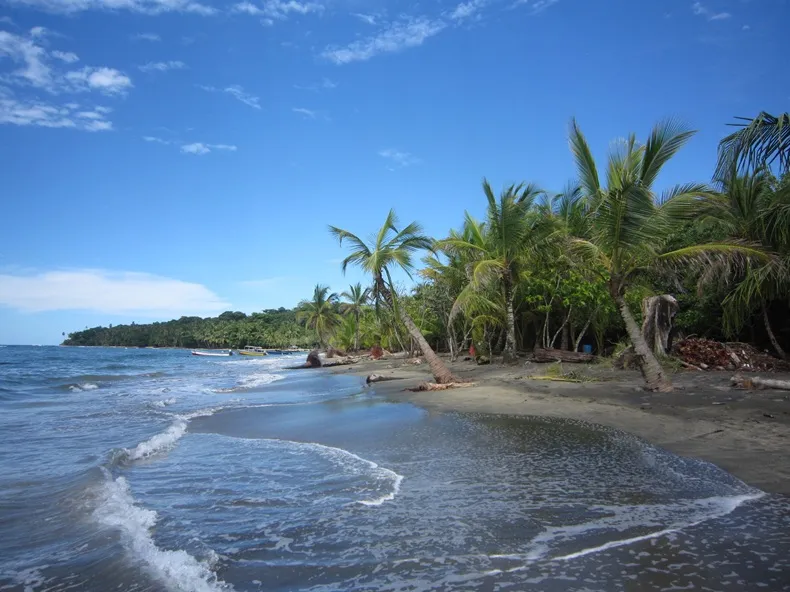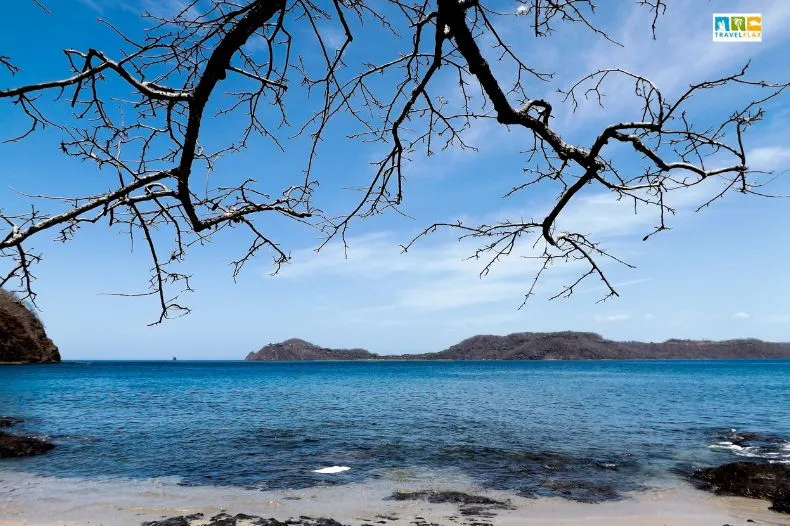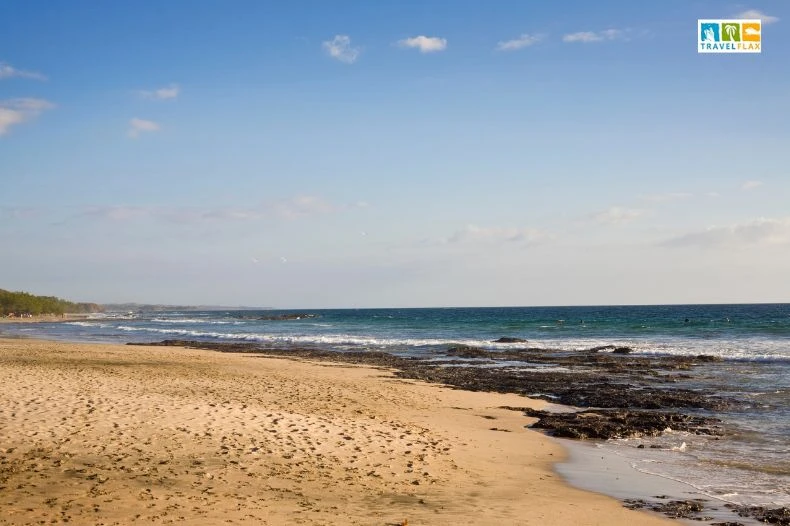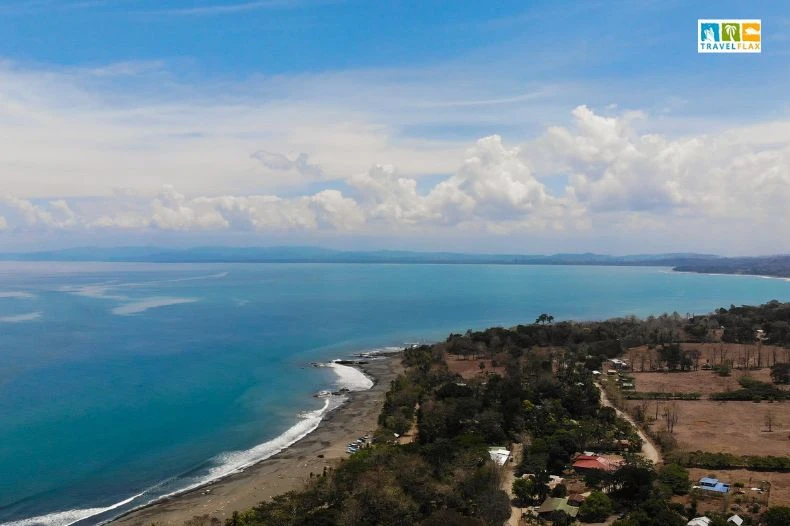Costa Rica‘s stunning coastlines offer a unique twist on tropical paradise. Among its many beautiful beaches, Black sand beaches in Costa Rica stand out as something truly special. These dark, striking shores form from volcanic activity and lava flows cooling in the ocean.
Costa Rica has several amazing black sand beaches to explore, each with its own character and appeal. Some popular spots include Playa Negra in Puerto Viejo and another Playa Negra in Guanacaste. These beaches offer a mix of relaxation, surfing, and natural beauty.
Black sand beaches in Costa Rica provide more than just a pretty view. They’re often near wildlife areas and parks, making them great for spotting local animals and plants. Many also have good waves for surfing or calm waters for swimming.
Key Takeaways
- Costa Rica’s black sand beaches result from volcanic activity and offer unique coastal experiences
- These beaches provide opportunities for surfing, wildlife viewing, and relaxation in stunning settings
- Visitors can find black sand beaches on both the Caribbean and Pacific coasts of Costa Rica
Exploring the Unique Beauty of Black Sand Beaches in Costa Rica
Costa Rica’s black sand beaches are a stunning sight to behold. These dark shores stand out from typical golden or white sand beaches found elsewhere.
The black sand comes from volcanic activity. When lava cools and breaks down, it creates tiny fragments of dark rock. These pieces mix with regular sand to form black sand beaches.
Iron oxide in the volcanic sand gives it a deep, rich color. This dark hue absorbs more sunlight, making the sand quite warm to walk on.
Black sand beaches offer amazing scenic views. The contrast between the dark shore and blue ocean creates a striking visual.
Some popular black sand beaches in Costa Rica include:
- Puerto Viejo
- Playa Negra in Guanacaste
- Playa Pavones
- Playa Hermosa
These beaches are great for relaxing, surfing, or simply enjoying the unique scenery. Visitors should bring water shoes, as the sand can get very hot during sunny days.
Black sand beaches add to Costa Rica’s diverse coastal landscapes. They showcase the country’s volcanic history and provide a one-of-a-kind beach experience for tourists and locals alike.
Popular Black Sand Beaches In Costa Rica
Costa Rica boasts several stunning black sand beaches, each with its own unique charm and attractions. These volcanic beaches offer visitors a chance to experience nature’s beauty and enjoy various activities.
Puerto Viejo: Caribbean Charm and Surfing Scene

Puerto Viejo, located on Costa Rica’s Caribbean coast, is home to beautiful black sand beaches. The area’s laid-back vibe and vibrant culture make it a popular destination for travelers.
Surfers flock to Puerto Viejo one of the best black sand beaches in Costa Rica, for its excellent waves. The beach offers breaks suitable for both beginners and experienced surfers.
Besides surfing, visitors can enjoy:
- Snorkeling in coral reefs
- Bike rides along coastal paths
- Exploring nearby wildlife refuges
Puerto Viejo’s black sand beaches are perfect for sunbathing and swimming. The contrast between the dark sand and turquoise waters creates a stunning visual effect.
Playa Hermosa: A Haven for Surfers and Sunbathers

Playa Hermosa, meaning “Beautiful Beach,” lives up to its name with its striking black sand coastline. This beach is a favorite among surfers due to its consistent waves.
The beach stretches for miles, providing ample space for sunbathing and beachcombing. Visitors can enjoy:
- Surfing lessons for beginners
- Beach volleyball
- Spectacular sunsets
Playa Hermosa’s waters are suitable for swimming, but caution is advised due to strong currents. The beach is less crowded than some other popular destinations, offering a more relaxed atmosphere.
Playa Negra: Tranquility and Pristine Waters

Playa Negra, which translates to “Black Beach,” is known for its serene environment and beautiful scenery. The beach’s dark sand creates a dramatic contrast with the lush green vegetation that surrounds it.
Visitors to Playa Negra can enjoy:
- World-class surfing spots
- Peaceful walks along the shore
- Spotting local wildlife
The beach is less developed than some other Costa Rican destinations, making it ideal for those seeking a more authentic experience. Nearby accommodations range from eco-lodges to boutique hotels.
Playa Pavones: Longest Warm Water Left-Hand Wave

Playa Pavones is a surfer’s paradise, famous for having one of the longest left-hand waves in the world. The beach’s remote location adds to its allure, attracting adventurous travelers.
The black sand beach stretches for miles, offering plenty of space for various activities:
- Surfing the legendary waves
- Hiking in nearby rainforests
- Sport fishing in the rich coastal waters
Playa Pavones is surrounded by lush jungle, providing opportunities to spot diverse wildlife. The area’s unspoiled beauty makes it a perfect destination for nature lovers and photographers.
Wildlife and Natural Parks Near the Beaches
Costa Rica’s black sand beaches are close to amazing national parks. These parks protect diverse ecosystems and rare wildlife. Visitors can see animals and plants found nowhere else on Earth.
Cahuita National Park: A Mosaic of Biodiversity
Cahuita National Park is a gem on Costa Rica’s Caribbean coast. It’s home to a rich variety of wildlife. The park has both land and sea areas, making it unique.
Visitors can spot:
- Howler monkeys
- Sloths
- Toucans
- Poison dart frogs
The park’s coral reef is a major draw. It’s the largest in Costa Rica. Snorkelers can see colorful fish and sea turtles.
Cahuita’s tropical forest is lush and green. Hiking trails let visitors explore the dense vegetation. Lucky hikers might see a rare bird or mammal.
Marina Las Baulas National Park: Marine Life and Conservation
Marina Las Baulas National Park is on Costa Rica’s Pacific coast. It’s famous for its leatherback sea turtles. These giant turtles come to lay eggs on the park’s beaches.
The park works hard to protect these endangered animals. Visitors can join guided tours to watch turtles nest at night. It’s a magical experience that supports conservation efforts.
Besides turtles, the park has other marine life. Whales and dolphins swim offshore. Mangrove forests provide homes for many bird species.
The park’s black sand beaches are beautiful and important. They’re nesting sites for turtles and home to small creatures. Visitors should tread lightly to protect these delicate ecosystems.
Recreational Activities on Black Sand Beaches
Black sand beaches in Costa Rica offer a range of fun activities for visitors. These unique beaches provide great spots for relaxation and adventure.
Sunsets and Sunbathing: Leisure at Its Best
Black sand absorbs more heat than light-colored sand, making it perfect for sunbathing. Visitors can soak up the warmth while enjoying the stunning views.
The dark sand creates a beautiful contrast with the ocean, making for amazing sunset photos. Many beachgoers gather in the evening to watch the sky turn vibrant colors as the sun dips below the horizon.
Swimming is also popular, but be careful of strong currents at some beaches. Always check local conditions and swim in designated areas.
Surfing Spots for All Levels: From Beginners to Pros
Costa Rica’s black sand beaches offer great surfing opportunities. Playa Hermosa on the Central Pacific Coast is known for its consistent waves suitable for all skill levels.
Beginner surfers can take lessons from local instructors who know the area well. More experienced surfers can challenge themselves with bigger swells.
Some beaches have surf shops nearby where you can rent boards and get tips on the best spots to catch waves.
Snorkeling and Diving: Exploring the Underwater World
Many black sand beaches in Costa Rica have rich marine life just offshore. Snorkelers can see colorful fish, sea turtles, and vibrant coral reefs in the clear waters.
For more adventurous visitors, scuba diving tours are available at some beaches. These trips allow you to explore deeper waters and see larger sea creatures.
Always use proper equipment and go with a certified guide for the best and safest experience. Some beaches have calmer waters that are better for snorkeling, while others are better suited for diving.
Cuisine and Local Restaurants by the Coast
Costa Rica’s coastal areas offer a unique dining experience. Visitors can enjoy fresh seafood and local dishes while taking in beautiful ocean views.
Sampling Fresh Seafood and Local Delicacies
Costa Rica’s Caribbean coast is home to many beachfront restaurants that serve fresh seafood and local specialties. These eateries often use ingredients from nearby farms and the sea.
Diners can try dishes like ceviche, made with raw fish marinated in citrus juice. Grilled fish and coconut-flavored seafood stews are also popular choices.
Many coastal restaurants offer a mix of Caribbean and Costa Rican flavors. Rice and beans, plantains, and tropical fruits are common side dishes.
Some beach towns, like Puerto Viejo, have a variety of local restaurants near their black sand beaches. These spots serve both traditional and international cuisine.
Visitors can find everything from small beachside cafes to upscale dining options. Many places offer outdoor seating with ocean views, adding to the dining experience.
Accommodation and Amenities
Staying near Costa Rica’s black sand beaches offers a range of options for families and couples alike. Visitors can find places to stay that suit different budgets and preferences.
Family-Friendly Options and Romantic Getaways
Costa Rica’s black sand beaches have hotels with luxurious bungalows set in tropical gardens. These are perfect for couples seeking a romantic escape. Families can find spacious suites with kitchen facilities for convenience.
Many beachfront properties offer easy access to the unique ecosystem. Kids can explore tidal pools and spot local wildlife right outside their rooms.
Restaurants and bars near the beaches serve fresh seafood and local dishes. This lets guests enjoy meals with ocean views.
Some areas have surf schools, great for families wanting to try a new activity together. Parking is often available, making it easy for those who rent a car.
Remember to book early, especially during peak seasons. This ensures you get the best spots close to the striking black sand shorelines.
Comparing Black Sand with White Sand Beaches in Costa Rica
Costa Rica offers a variety of stunning beaches, including both black and white sand options. Each type has its own unique features and appeal.
Black sand beaches in Costa Rica form from volcanic activity. The dark sand absorbs more heat, making these beaches warmer underfoot. Black sand beaches are less common and offer a striking visual contrast against the blue ocean.
White sand beaches are more prevalent in Costa Rica. They have a softer, silkier texture that many visitors prefer. These beaches reflect more sunlight, keeping the sand cooler to walk on.
Here’s a quick comparison:
| Feature | Black Sand Beaches | White Sand Beaches |
|---|---|---|
| Origin | Volcanic | Coral and shells |
| Temperature | Warmer | Cooler |
| Prevalence | Less common | More common |
| Texture | Coarser | Softer, silkier |
Popular black sand beaches include Playa Negra in Guanacaste. For white sand, visitors often flock to Playa Grande on the Pacific coast.
Both types of beaches offer unique experiences. Black sand beaches provide dramatic landscapes, while white sand beaches deliver the classic tropical paradise feel. Travelers can enjoy swimming, surfing, and sunbathing at either type of beach in Costa Rica.
Travel Tips and Best Times to Visit
Costa Rica’s black sand beaches offer unique experiences year-round. The best time to visit is during the dry season from December to April. This period brings warm, sunny weather ideal for beach activities.
Pack essentials like sunscreen, water shoes, and insect repellent. The black sand can get very hot, so protect your feet.
Be aware of strong currents, especially on the Pacific coast. Always check local conditions before swimming or surfing.
The Central Pacific Coast and Southern Zone have popular black sand beaches. These areas offer great surf breaks for experienced surfers.
On the Caribbean Coast, visit Playa Negra in Puerto Viejo, Limón. This beach is known for its laid-back atmosphere.
The Osa Peninsula in the south has secluded black sand beaches. It’s perfect for nature lovers and wildlife spotting.
Remember to respect the environment. Many beaches are near important nesting sites for sea turtles.
Bring a camera to capture the striking contrast between the black sand and blue ocean. The scenery is truly unforgettable.
Frequently Asked Questions
Costa Rica offers several unique black sand beaches, each with its own charm and attractions. Visitors can find these beaches in various regions, from popular tourist spots to more secluded areas.
What are the most popular black sand beaches to visit in Costa Rica?
Playa Negra in Puerto Viejo is a popular black sand beach on Costa Rica’s Caribbean coast. It’s known for its laid-back atmosphere and great surfing conditions.
Another well-known black sand beach is Playa Hermosa, located on the Central Pacific Coast. This beach is easily accessible from San Jose and offers a busier, more social vibe.
Where can I find a map showcasing black sand beaches in Costa Rica?
Many travel websites and guidebooks provide maps of Costa Rica’s beaches, including black sand ones. Local tourist offices in Costa Rica often offer free maps highlighting different beach types and locations.
Online resources like Google Maps can also be helpful for locating black sand beaches along Costa Rica’s coastlines.
Can you recommend some resorts located on black sand beaches in Costa Rica?
Several resorts can be found near black sand beaches in Costa Rica. Some options include eco-lodges and boutique hotels in Puerto Viejo, close to Playa Negra.
Near Playa Hermosa on the Central Pacific Coast, visitors can find a range of accommodations from luxury resorts to budget-friendly options.
Which black sand beaches are closest to San Jose, Costa Rica?
Playa Hermosa on the Central Pacific Coast is one of the closest black sand beaches to San Jose. It’s about a 1 hour and 45-minute drive from the capital city.
Other black sand beaches within a few hours’ drive from San Jose include those along the Caribbean coast, though they are slightly farther away.
Are there unique beach colors in Costa Rica, such as pink sand beaches?
Costa Rica is primarily known for its white, golden, and black sand beaches. Pink sand beaches are not commonly found in the country.
The black sand beaches are a result of volcanic activity, which is abundant in Costa Rica with over 60 volcanoes.
What are the distinctive features of Playa Hermosa’s black sand beach?
Playa Hermosa’s black sand beach offers a mix of natural beauty and social atmosphere. It’s located about 5 kilometers south of Jaco, a popular beach town.
The beach is known for its cleanliness and is easily accessible. It provides a good balance of relaxation and nearby amenities for visitors.
